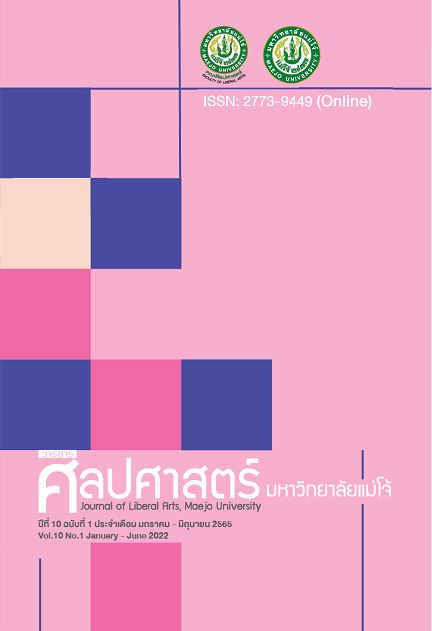ผลของโปรแกรมการออกกำลังกายด้วยตารางตั้งเตที่มีต่อองค์ประกอบของ ร่างกายและคุณภาพชีวิต ในเด็กที่มีภาวะน้ำหนักเกิน
Main Article Content
บทคัดย่อ
การวิจัยนี้มีวัตถุประสงค์เพื่อศึกษาผลของโปรแกรมการออกกำลังกายด้วยตารางตั้งเตต่อองค์ประกอบของร่างกายและคุณภาพชีวิตในเด็กที่มีภาวะน้ำหนักเกิน อายุ 10–12 ปี จำนวน 38 คน แบ่งเป็น 2 กลุ่มๆละ 19 คน ใช้วิธีการจับคู่ กลุ่มควบคุมใช้ชีวิตตามปกติและกลุ่มทดลองได้รับโปรแกรม 60 นาที 3 วันต่อสัปดาห์ รวม 6 สัปดาห์ ทดสอบองค์ประกอบของร่างกายและแบบสอบถามคุณภาพชีวิต เปรียบเทียบค่าเฉลี่ยภายในกลุ่มและระหว่างกลุ่ม ผลการวิจัยพบว่า
1) กลุ่มทดลองมีค่าเฉลี่ยเปอร์เซ็นต์ไขมันลดลง มีมวลน้ำหนักตัวไม่รวมไขมัน มวลกล้ามเนื้อเพิ่มขึ้นอย่างมีนัยสำคัญทางสถิติที่ระดับ 0.05 กลุ่มควบคุมมีค่าเฉลี่ยมวลกล้ามเนื้อเพิ่มขึ้นมากกว่าก่อนการทดลองอย่างมีนัยสำคัญทางสถิติที่ระดับ 0.05 คุณภาพชีวิตฉบับของเด็กสองกลุ่มไม่ต่างกัน ส่วนคุณภาพชีวิตฉบับของผู้ปกครองกลุ่มทดลองดีกว่าก่อนการทดลองอย่างมีนัยสำคัญทางสถิติที่ระดับ 0.05
2) ระหว่างกลุ่ม กลุ่มทดลองมีค่าเฉลี่ยมวลน้ำหนักตัวไม่รวมไขมันเพิ่มขึ้นอย่างมีนัยสำคัญทางสถิติที่ 0.05 คุณภาพชีวิตฉบับของเด็กไม่ต่างกัน ส่วนคุณภาพชีวิตฉบับของผู้ปกครองกลุ่มทดลองดีกว่ากลุ่มควบคุมอย่างมีนัยสำคัญทางสถิติที่ 0.05
บทสรุปและวิจารณ์ โปรแกรมการออกกำลังกายด้วยตารางตั้งเตสามารถเปลี่ยนแปลง เปอร์เซ็นต์ไขมันในร่างกาย มวลน้ำหนักตัวไม่รวมไขมัน มวลกล้ามเนื้อและช่วยพัฒนาคุณภาพชีวิตของเด็กมีภาวะน้ำหนักเกิน ภายใน 6 สัปดาห์ โปรแกรมการออกกำลังกายด้วยตารางตั้งเตอาจเป็นทางเลือกกิจกรรมพิเศษในโรงเรียนได้
Article Details

This work is licensed under a Creative Commons Attribution-NonCommercial-NoDerivatives 4.0 International License.
ต้นฉบับที่ได้รับการตีพิมพ์ในวารสารคณะศิลปศาสตร์ มหาวิทยาลัยแม่โจ้ ถือเป็นกรรมสิทธิ์ของมหาวิทยาลัยแม่โจ้ ห้ามนำข้อความทั้งหมดหรือบางส่วนไปพิมพ์ซ้ำ เว้นเสียแต่จะได้รับอนุญาตจากมหาวิทยาลัยฯ เป็นลายลักษณ์อักษรReferences
กัลยาณี โนอินทร์. (2560). ภาวะน้ำหนักเกินและโรคอ้วนในวัยเรียนและวัยรุ่นไทย. วารสารทหารบก. 18 (ฉบับพิเศษ), 2-8.
วรารัตน์ กาแปง. (2562). ของเล่นเพื่อส่งเสริมพัฒนาการเด็ก ตั้งเต : HOPSCOTCH (ซิกกะแดะ, กระต่ายขาเดียว). สืบค้น 15 มีนาคม 2563 จาก https://wbscort.dusit.ac.th/artefect/file/
ศิริเพ็ญ สมใจ. (2549). วิเคราะห์ต้นทุนและคุณภาพชีวิตของผู้ป่วยธาลัสซีเมียหลังการรักษาโดยการปลูกถ่ายไขกระดูกในโรงพยาบาลจุฬาลงกรณ์ (วิทยานิพนธ์ปริญญามหาบัณฑิต). กรุงเทพฯ : จุฬาลงกรณ์มหาวิทยาลัย.
ศุภวรรณ วงศ์สร้างทรัพย์. (2551). ผลของการฝึกโปรแกรมการละเล่นพื้นบ้านที่มีต่อสมรรถภาพทางกายเพื่อ สุขภาพของนักเรียนชั้นประถมศึกษาตอนต้น (วิทยานิพนธ์ปริญญามหาบัณทิต) กรุงเทพฯ : มหาวิทยาลัยเกษตรศาสตร์.
สาธารณสุข, กระทรวง กรมอนามัย. (2542). กราฟแสดงเกณฑ์อ้างอิงการเจริญเติบโตของเพศชายและเพศหญิงอายุ 5-18 ปี. กรุงเทพฯ : โรงพิมพ์ชุมนุมสหกรณ์การเกษตรแห่งประเทศไทย.
สาธารณสุข, กระทรวง กรมอนามัย. (2557). แนวทางการควบคุมป้องกันภาวะอ้วนในเด็กนักเรียน. สืบค้น 13 มกราคม 2563 จาก https://www.lamphunhealth.go.th/
สำนักงานกองทุนสนับสนุนการสร้างเสริมสุขภาพ. (2561). เด็กไทยกิจกรรมทางกายน้อย แนะคนกรุงหมั่นดูแลสุขภาพ. สืบค้น 29 เมษายน 2563 จาก https://www.thaihealth.or.th/
American College of Sports Medicine. (2018). ACSM's guidelines for exercise testing and prescription: Lippincott. Williams & Wilkins.
Chuensiri, N., Suksom, D., & Tanaka, H. (2018). Effects of high-intensity intermittent training on vascular function in obese preadolescent boys. Childhood Obesity. 14(1), 41-49.
Cox, R. C., & Vargas, J.S. (1966). A comparison of item selection techniques for normreferenced and criterion referenced test. Paper presented at the Annual Meeting of National Council on Measurement in Education.
Demirci, N., Demirci, P. T., & Demirci, E. (2017). The Effect of School-Based Exercise Practices of 9-11 Year Old Girls Students on Obesity and Health-Related Quality of Life. Universal Journal of Educational Research. 5(8), 1323-1331.
Faul, F., Erdfelder, E., Lang, A. G., & Buchner, A. (2007). G* Power 3: A flexible statistical power analysis program for the social, behavioral, and biomedical sciences. Behavior Research Methods. 39(2), 175-191.
Kesztyus, D., Wirt, T., Kobel, S., Schreiber, A., Kettner, S., Dreyhaupt, J., ... & Steinacker, J. M. (2013). Is central obesity associated with poorer health and health-related quality of life in primary school children? Cross-sectional results from the Baden-Württemberg Study. BMC Public Health, 13(1), 260.
Lau, P. W., Wong, D. P., Ngo, J. K., Liang, Y., Kim, C. G., & Kim, H. S. (2015). Effects of high-intensity intermittent running exercise in overweight children. European Journal of Sport Science. 15(2), 182-190.
Lu, K. D., Cooper, D. M., Haddad, F., & Radom-Aizik, S. (2018). Four months of a school-based exercise program improved aerobic fitness and clinical outcomes in a low-SES population of normal weight and overweight/obese children with asthma. Frontiers in Pediatrics. 6, 380.
Morrison, K. M., Shin, S., Tarnopolsky, M., & Taylor, V. H. (2015). Association of depression & health related quality of life with body composition in children and youth with obesity. Journal of Affective Disorders. 172, 18-23.
Shoup, J. A., Gattshall, M., Dandamudi, P., & Estabrooks, P. (2008). Physical activity, quality of life, and weight status in overweight children. Quality of Life Research. 17(3), 407-412.
Sothern, M. S. (2001). Exercise as a modality in the treatment of childhood obesity. Pediatric Clinics of North America. 48(4), 995-1015.
Tompkins, C. L., Soros, A., Sothern, M. S., & Vargas, A. (2009). Effects of physical activity on diabetes management and lowering risk for type 2 diabetes. American Journal of Health Education. 40(5), 286-290.
Varni, J. W., Seid, M., & Kurtin, P. S. (2001). PedsQL™ 4.0: Reliability and validity of the Pediatric Quality of Life Inventory™ Version 4.0 Generic Core Scales in healthy and patient populations. Medical care. 800-812.
Williams, C. F., Bustamante, E. E., Waller, J. L., & Davis, C. L. (2019). Exercise effects on quality of life, mood, and self-worth in overweight children: the SMART randomized controlled trial. Translational Behavioral Medicine. 9(3), 451-459.
World Health Organization (WHO). (2017). Obesity and overweight. Retrieved 6 July 2020 from http://www.who.int/news-room/
